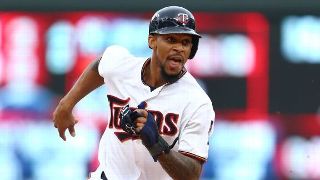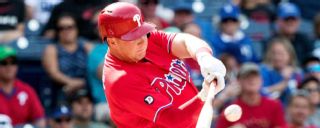|
On Aug. 5, the Texas Rangers beat the Minnesota Twins 4-1 as Rangers starter Cole Hamels fired a four-hit complete game. The Twins fell to 52-56, and, though they were only four games out of the second wild card, there were six teams ahead of them. It appeared they were merely playing out the string. Then something remarkable happened. Everybody started hitting. Through their first 108 games, the Twins had averaged 4.48 runs per game, ranking 20th in the majors. They beat the Rangers 6-5 on Aug. 6 to kick off a six-game winning streak. They swept the Arizona Diamondbacks at home, scoring 27 runs in three games. They had 10-2 and 11-1 wins over the Chicago White Sox. In September, they had 17-0 and 16-0 wins over the Kansas City Royals and San Diego Padres. Battling for a wild card the final 10 days, the Twins went into Detroit and swept a four-game series, scoring 39 runs. Over those final 54 games, the Twins went 33-21, won the wild card and pounded baseballs. They averaged 6.13 runs per game, most in the majors over that stretch. The Oakland Athletics and Philadelphia Phillies didn’t surge to the playoffs, but both teams also experienced much-improved second-half offensive performances. The A's improved from 4.29 runs per game in the first half to 4.89 in the second, including 5.07 per game from Aug. 1 through the end of the season. The Phillies scored just 3.82 runs per game before the All-Star break, 4.77 after. It's no coincidence those lineups improved after Matt Olson and Rhys Hoskins were called up from the minors and tore it up down the stretch. So here's the question: Are those second-half performance indicators that the Twins, A's and Phillies could have breakout offenses in 2018? I did some research looking back through first-half and second-half team offense from 2012 to 2016. That's five seasons of data and the changes in offense in those years -- big increases the past two seasons, a big dip in 2014 -- skew the numbers when comparing one season to the next. The results are further complicated, as West Coast teams often score fewer runs in the first half due to weather conditions. I pinpointed the five teams with the largest gains within each season and 11 of the 25 were West Coast teams. Looked at as a whole, there is anecdotal evidence both ways. The 2016 Atlanta Braves had a 1.30-run improvement in the second half, ranking fifth in the majors in runs per game. Braves fans believed this was a sign of a much better offense for 2017; they finished 19th in runs per game in 2017 (yes, Freddie Freeman missed some time). The 2015 New York Mets improved by 1.63 runs per game in the second half of 2015; they ranked 26th in the majors in runs per game in 2016. On the other side, the 2012 A's scored 1.47 runs per game more in the second half, best in the majors, and would rank fourth in runs in 2013. The 2015 Seattle Mariners had a 1.20-run increase and ranked sixth in runs the following season. While 13 of the 25 teams scored more runs the following season, the 25 teams collectively lost 22 more games (although those totals are heavily affected by the 2013 Boston Red Sox and Rangers, who combined for 50 more losses the following season). A positive indicator for the Twins, A’s and Phillies is that four of last year's five second-half gainers did improve: Braves (1.30 more runs in second half): plus-4 wins
Mets (0.73 more runs): minus-17 wins
Dodgers: (0.63 more runs): plus-13 wins
Rays (0.52 more runs): plus-12 wins
Brewers (0.46 more runs: plus-13 wins In theory, second-half performance as an indicator for the following season works best for young teams, the idea being that young players are improving. Let's see why our three teams could have breakout offenses in 2018. Minnesota Twins Of the 10 Twins hitters with the most playing time, only three were 30 or older and five were in their age-25 season or younger. The most promising second-half breakout belonged to Byron Buxton, who hit .300/.347/.546. With his defense, he’s an MVP candidate if he can hit like that for an entire season. Eddie Rosario and Jorge Polanco had big power surges, with Rosario slugging .558 and Polanco slugging .511. Rosario popped 17 home runs in 70 games in the second half. Veteran Brian Dozier has had monster second halves two seasons in a row and ranked sixth in the majors with 21 second-half home runs.  That all sounds good, but here are some red flags. As a team, the Twins essentially had the same strikeout rate and strikeout-to-walk ratio in both halves. Their BABIP increased from .302 to .310, but most of their offensive gains came via simply hitting more home runs. As good as Buxton and Rosario were, they still have low walk rates and Buxton struck out five times for every walk in the second half. I'd like to see both of them clean up their chase rate before completely buying into their second-half numbers. The Twins also feasted of some bad pitching from the Tigers, White Sox and Royals. But, hey, those three teams are still in the AL Central. That all sounds good, but here are some red flags. As a team, the Twins essentially had the same strikeout rate and strikeout-to-walk ratio in both halves. Their BABIP increased from .302 to .310, but most of their offensive gains came via simply hitting more home runs. As good as Buxton and Rosario were, they still have low walk rates and Buxton struck out five times for every walk in the second half. I'd like to see both of them clean up their chase rate before completely buying into their second-half numbers. The Twins also feasted of some bad pitching from the Tigers, White Sox and Royals. But, hey, those three teams are still in the AL Central.
While their offseason focus has understandably been on pitching -- maybe they’ll still end up with Yu Darvish, especially now with the news that Ervin Santana may be out until May -- runs are runs, and imagine J.D. Martinez in the middle of this lineup. If the Twins can't get Darvish, they should be willing to give that money to Martinez. He'd be a huge impact bat and could split his playing time between the outfield and DH, putting Max Kepler or Robbie Grossman into a bench role that improves the team's depth while also hedging against some regression from some of the other hitters. The Cleveland Indians are the clear favorite in the AL Central, but they rely heavily on their stellar rotation and three offensive players (Jose Ramirez, Francisco Lindor and Edwin Encarnacion). Michael Brantley and Jason Kipnis are injury-prone and if Cleveland suffers a couple injuries in the rotation, the Twins have a chance. They just haven't done anything to close the gap, and expecting the offense to score six runs per game over an entire season isn't realistic. Oakland Athletics If the A's were in the NL West instead of the AL West, they'd be a great sleeper pick. The bullpen has depth and could be pretty good, Stephen Piscotty could be one of those little pickups that pays a big dividend and they played .500 baseball in the second half. Most importantly, they have two potential stars in Matt Olson and Matt Chapman. Those two rookies keyed the improved offense. Olson was the big stud in the second half, hitting .286/.367/.721 with 20 home runs in 43 games (36 starts). Is he going to slug .721 over an entire season? No, but his fly ball swing is going to produce big power numbers. Chapman, who already looks like a Gold Glove defender, slugged .516 after the break. Like Olson, he has a lot of swing-and-miss in his game, but the power is legit -- he slugged 36 home runs in the minors in 2016. Neither is going to be a high-average hitter, but they could combine for 70 home runs. Throw in 43-homer basher Khris Davis, plus Matt Joyce and a deep arsenal of moving parts, and the A's could surpass last season’s 234 home runs, which ranked fourth in the AL. Philadelphia Phillies Like the A's, the Phillies were much improved in the second half, going 37-38 while scoring the same number of runs as their opponents. Hoskins was a reign of terror after his call-up, hitting .259/.396/.618 with 18 home runs in 170 at-bats. Sure, the 11 home runs in his first 18 games were freakish, but examine his track record and you see a guy who improved throughout his minor league career and drew 37 walks against 46 strikeouts in the majors. That plate discipline bodes well and he could be a consistent .400-OBP guy with 30-homer power. Sounds a little like Joey Votto to me. Hoskins isn’t the only reason to believe in the Phillies as a breakout offense. Carlos Santana replaces Tommy Joseph at first base, which means a big upgrade in the OBP department. Freddy Galvis and Maikel Franco were also OBP sinkholes and J.P. Crawford -- who posted a .356 OBP in his limited big league trial -- will replace Galvis at shortstop. Franco is still the third baseman, probably his last chance to prove himself as a major league regular. Aaron Altherr also had a breakout season, hitting .272/.340/.516, although he played just 29 games in the second half. So the Phillies will be better at first base, better in left field, probably better at shortstop and better in right field if Altherr stays healthy. Second baseman Scott Kingery could also make a major impact in the second half. The Phillies will also get to feast on some bad pitching from the Miami Marlins and Braves and maybe the Mets if their rotation can't stay healthy again. Like the Twins and A's, the Phillies' rotation has some concerns. They have the payroll flexibility to play in the free-agent game and even if they don’t want to pony up for Darvish, a couple budget-conscious signings like Lance Lynn and Alex Cobb could make them a potential wild-card contender. Going from 66 wins to 90 isn't likely, but it's possible. Just ask the Twins. They went from 59 to 85 and squeaked into the playoffs.
|

